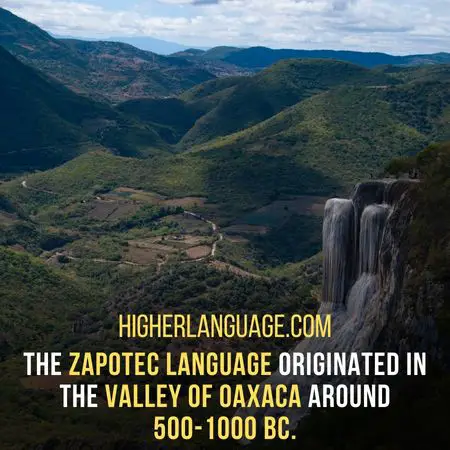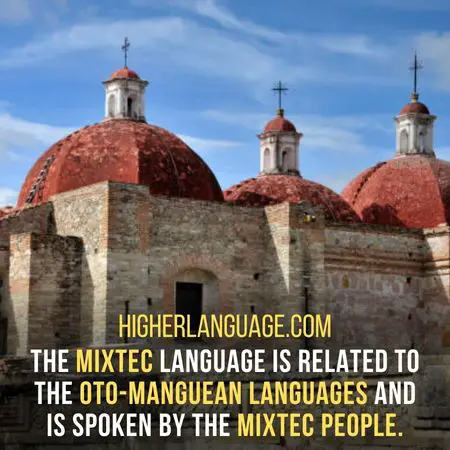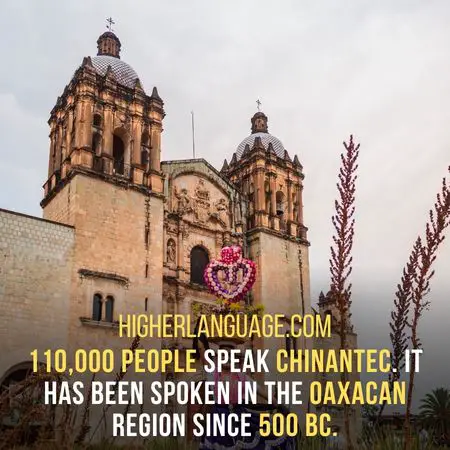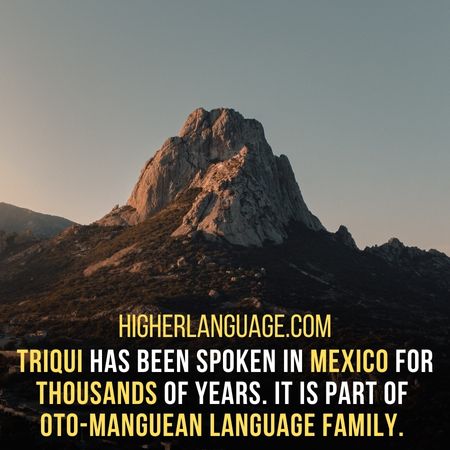There are many languages similar to Zapotec language. These languages are from the same Oto-Manguean family and share many features.
[toc]
These languages are all spoken in the same regions as Zapotec, making them closely related to each other.
Languages Similar To Zapotec:
Zapotec languages are a group of languages spoken by the Zapotec people, indigenous people who live in the Southern Mexican state of Oaxaca and Central American countries.

The Zapotec languages have been around for centuries but originated in the Valley of Oaxaca around 500-1000 BC.
They are part of the Oto-Manguean language family and are related to languages spoken by other indigenous peoples in Mexico, such as Mixtec, Chinantec, Triqui, and Mazatec.
These languages are spoken throughout Central America, mainly in Oaxaca and Guerrero, Mexico.
In addition to Zapotec languages, several other languages similar to Zapotec belong to this same family.
These languages include Mazatec, Mixtec, Chinantec, and Cuicatec.
While these languages have many differences, they share a certain degree of commonality. That similarity is mostly in terms of grammar and vocabulary.
Some languages that are most similar to Zapotec include Mixtec, Chinantec, Triqui, Mazatec, and Amuzgo.
1. Mazatec:
Mazatec is an Oto-Manguean language spoken by the Mazatec people in Oaxaca and Veracruz, Mexico.
It is closely related to languages in the same family, such as Mixtec and Zapotec.
However, it also shares similarities with languages outside its family, such as Mixe and Chinantec.
Mazatec is spoken by approximately 150,000 people and is the language of an estimated 2 million people.
It is primarily spoken in Huautla de Jimenez, Teotitlan del Valle, San Antonio Sinicahua, San Andres Tuxtla, and La Venta.
The Mazatec languages are related to the Zapotec languages and have a common origin in Oaxaca.
The languages are divided into two main branches Mazateco de Huautla and the languages of the Sierra Mazateca.
All languages in this family are endangered and are only spoken by a few hundred people.
Similarities:
Both languages have a complex verb system, such as multiple conjugations, moods, and tenses.
The languages also share many grammatical features lost in other languages, such as noun classifiers and dual number suffixes for plurals.
They both use vowel and consonant harmony. For example, when a suffix is added to a word, the vowels in the suffix also match those in the root.
Both languages have very similar phonology and have both been influenced by Spanish.
Both languages have grammatical gender distinctions. For example, a noun like “house” may have different gender-specific forms depending on your language.
The languages also share similar vocabulary and some loan words from each other. For example, the Zapotec word for ‘chicken‘ is similar to Mazatec’s.
In terms of syntax, both languages are verb-initial languages, meaning that the verb always appears first in a clause.
They also use pro-drop, which means that pronouns can often be omitted. Both languages share certain morphological features, such as reduplication and productive compounding.
Finally, the languages share similar phonological structures, such as consonant clusters and vowel harmony.
Differences:
The languages share many similarities, but there are also some differences. For example, Zapotec verbs inflect for person, number, and mood, while Mazatec does not.
Mazatec also has a less complicated noun classification system than Zapotec.
The languages also differ in terms of their syntactic structures, with Mazatec having a more flexible syntax than Zapotec.
Both languages have distinct dialects, further differentiating them from one another.
Furthermore, while they share many cognates, the languages also have many slang and colloquialisms that are exclusive to each language.
In short, there are some significant differences between Zapotec and Mazatec languages.
At their core, they are similar languages and share many aspects of their grammatical structures and vocabularies.
That makes it easier for speakers of either language to understand one another, even if the dialects differ.
Therefore Mazotec is one of the languages similar to Zapotec.
2. Mixtec:
Mixtec is an endangered language spoken by around 500,000 people across Central America.
It has a very rich vocabulary, and its speakers are known for their extensive knowledge of medicinal plants and traditional medicine.
Mixtec has also been historically used as a secret language among family members to keep private conversations from outsiders.

The Mixtec is also related to the Oto-Manguean languages and are spoken by the Mixtec people.
These languages are spoken in Oaxaca and Guerrero, two states in Mexico.
Similarities:
Both languages are part of the Oto-Manguean language family and share many similarities in their grammar and syntax.
For example, they both also use an ergative case system, meaning that verbs change depending on the sentence’s subject.
Both languages also have similar vowel structures with a three-way distinction between short, long, and nasal vowels.
Another similarity is that both languages are tonal, meaning that the pitch of a word can determine its meaning.
Finally, both languages use the same syllabary type, called an abugida.
That means that each syllable is written with a symbol that contains one or more consonants and a vowel.
Differences:
Although the languages are similar in many respects, there are also some important differences between them. The most notable difference is in their word order.
Zapotec languages typically follow a Subject-Object-Verb (SOV) structure. Mixtec languages tend to stick to a Subject-Verb-Object (SVO) structure.
Also, Mixtec language make use of reduplication – the repetition of whole syllables or words to create new phrases – while Zapotec languages do not.
Additionally, Mixtec distinguish between two genders in many nouns, while Zapotec typically omits this distinction.
Finally, Mixtec features tone – a different pitch given to certain syllables to distinguish meanings – while Zapotec does not.
All in all, the languages similar to Zapotec show great similarities, yet small differences that make them distinct.
However, despite their distinctions, these languages remain close enough that many speakers of Zapotec languages can also understand other languages like Mixtec and vice versa.
These similarities make the languages of Oaxaca so unique and fascinating!
3. Chinantec:
Chinantec is spoken in the region of Oaxaca, Mexico, and are closely related to Zapotec.
Chinantec is spoken in the Sierra de Juárez and the Sierra de Zongolica in eastern Oaxaca.
It is divided into two languages, San Francisco Huehuetlán Chinantec and San Jerónimo Tecóatl Chinantec.

It is spoken by about 110,000 people and is characterized by its unique tones. Chinantec has been spoken in the Oaxacan region since 500 BC.
The languages are considered descended from the ancient languages of Mixteco-Zoquean, which is believed to be the oldest language family that has survived in Mesoamerica.
Chinantec shares various similarities with Zapotec.
Similarities:
Both are tonal, meaning they use different tone levels and lengths to distinguish between words with the same spelling.
Chinantec uses suffixes similar to those used in Zapotec, including prefixes and infixes, which add additional meaning to a word or phrase.
The languages also share many of the same glyphs or symbols used to represent words. The languages also have similar grammatical structure, syntax, and word order variations.
Both languages have evolved, incorporating aspects of other languages and cultures they have encountered.
Differences:
While one of the languages similar to Zapotec, Chinantec has a few distinct features that make it stand out.
For instance, the vowel system in Chinantec is less complex than that of Zapotec due to its smaller inventory of vowels and lack of tonal distinctions.
Additionally, Chinantec uses simple prefixes rather than the more complex systems used in Zapotec.
That can make it easier for those learning the language to understand how words and phrases are constructed.
Finally, Chinantec also has a greater emphasis on certain syllables compared to other languages similar to Zapotec languages.
4. Triqui:
Triqui is spoken by the native Trique people in Mexico, primarily in Oaxaca. As with Chinantec, it, too, has fewer phonemes than Zapotec languages and lack tone distinctions. That can make them easier to learn for some language learners.

Approximately 50,000 people speak Triqui. Triqui has been spoken in Mexico for thousands of years and is part of the Oto-Manguean language family.
These languages began to spread during the Preclassic period (1,200 BCE – 250 CE) when speakers moved from the Gulf Coast to what is now the Sierra Madre del Sur region.
Triqui shares various similarities with Zapotec. Let us explore further.
Similarities:
Both languages are tonal, meaning that the meaning of words can change depending on their pitch.
Both languages also have noun-class distinctions based on gender and animacy.
They also share similarities in verb morphology, such as aspect marking and directional prefixes. They both use reduplication to form words and have similar forms of negation.
Both languages also share many phonological features. Those include the bilabial stops, glottalized consonants, and other sound changes.
In terms of lexicon, there are numerous similarities between Zapotec and Triqui languages which suggest a common origin for the languages.
That includes numerous shared terms for flora and fauna, as well as other items such as tools and kinship terms.
Additionally, the languages share similar grammatical features, such as subject-object-verb order and noun classification systems based on gender and animacy.
They also share verb morphology, such as aspect marking, directional prefixes, and reduplication.
Differences:
Although the languages share significant similarities, several differences set them apart.
For example, Zapotec has a richer consonant inventory and uses tones, while Triqui languages do not.
Additionally, Zapotec tend to be more verb-heavy, with longer phrases than the shorter ones found in Triqui languages.
While they share certain features in common, they can also differ significantly in terms of phonology and lexicon.
Finally, Triqui uses possessive prefixes, while Zapotec does not.
5. Amuzgo:
Amuzgo is a language of the Oto-Manguean languages family, spoken by the Amuzgo people in Guerrero and Oaxaca states in Mexico.
It has two main variants: Southern Amuzgo, which is primarily spoken in Guerrero, and Northern Amuzgo, which is mainly spoken in Oaxaca.

Around 100,000 people speak Amuzgo. It was first documented in the 16th century.
Amuzgo is believed to have originated from the Proto-Oto-Manguean languages, a language widely spoken in Central and Southern Mexico before Spanish colonization.
The Amuzgo also share many similarities with the Zapotec languages.
Similarities:
Both languages have similar roots, which is why they are related languages.. Both languages share many similarities in terms of morphology, syntax, and phonology.
For example, both languages have a consonant system with similar sounds. Amuzgo and Zapotec also use prefixes to indicate possession or ownership of something.
In addition, both languages employ the same type of verb stems for expressing future tenses.
They both use the same syllable structure and many of the same words, for example, “te“, which means “you” in both languages.
Amuzgo has borrowed some vocabulary from Zapotec languages over time.
Finally, both languages use a variety of suffixes in order to form new words.
Therefore, the languages Amuzgo and Zapotec are similar in many ways.
Differences:
Though both languages are members of the Oto-Manguean languages, Zapotec and Amuzgo have some distinct differences.
The most notable difference is that the two languages have different tonal systems—Zapotec has four tones, while Amuzgo only has two.
Additionally, the grammar structure of Amuzgo is more complex than Zapotec, with a greater emphasis on suffixes and postpositions.
Another difference is that Zapotec languages have more vocal sounds and phonemes than Amuzgo languages.
Additionally, the languages also differ in their writing systems—Zapotec is written with Latin characters.
In contrast, Amuzgo is written with an alphabet consisting of both Latin and syllabic characters.
Finally, Zapotec has a greater number of dialects than Amuzgo. While the languages are similar in some ways, they are also quite different in others.
Final thoughts:
Ultimately, languages similar to Zapotec—such as Amuzgo—are fascinating examples of languages that share similarities yet also have distinct differences.
Understanding these nuances can help us develop a better appreciation for the diversity and complexity of languages worldwide.
In addition, it is interesting to see how languages develop over time, with some becoming more complex and others staying relatively simple.
As linguists continue to study languages like these, we can gain a better understanding of how languages evolve and interact with one another.
No matter how languages change over time, their origins remain the same — a testament to the importance of language in our lives.